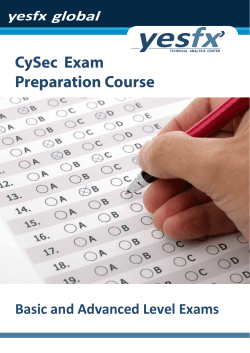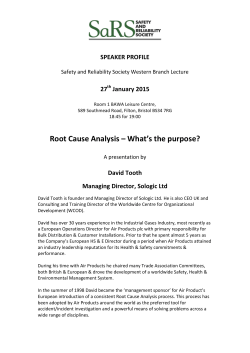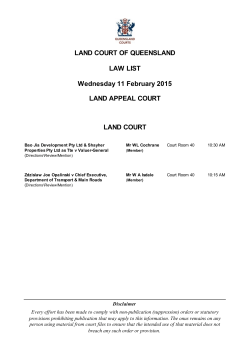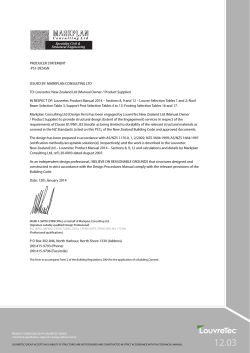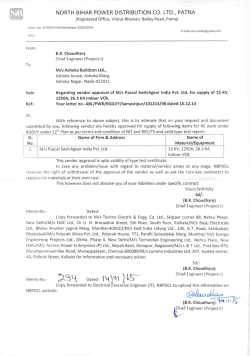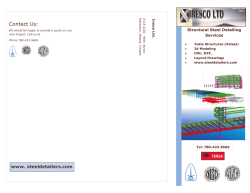
FAC4864, NFA4864, ZFA4864
FAC4864/101/0/2015 ZFA4864/101/0/2015 NFA4864/101/0/2015 Tutorial Letter 101/0/2015 APPLIED FINANCIAL ACCOUNTING II FAC4864/ZFA4864/NFA4864 Year module Department of Financial Governance This tutorial letter contains important information about your module. Bar code CONTENTS 1 INTRODUCTION ......................................................................................................................... 3 2 COMMUNICATION WITH THE UNIVERSITY ............................................................................. 3 2.1 2.2 2.3 Lecturers...................................................................................................................................... 3 Department .................................................................................................................................. 4 University ..................................................................................................................................... 4 3 MODULE RELATED RESOURCES ............................................................................................ 5 3.1 3.2 3.3 Tutorial matter.............................................................................................................................. 5 Prescribed books ......................................................................................................................... 5 Calculator policy .......................................................................................................................... 6 4 STUDENT SUPPORT SERVICES FOR THE MODULE .............................................................. 6 4.1 4.2 4.3 myUnisa ....................................................................................................................................... 6 Group discussions/Study schools ................................................................................................ 6 Unisa Library services information ............................................................................................... 6 5 MODULE SPECIFIC STUDY PLAN ............................................................................................ 7 5.1 5.2 Study programme ........................................................................................................................ 7 Content ........................................................................................................................................ 7 6 ASSESSMENT ............................................................................................................................ 8 6.1 6.2 6.2.1 6.2.2 6.2.3 6.2.4 6.2.5 6.3 Assessment plan ......................................................................................................................... 8 Tests ............................................................................................................................................ 8 Objectives .................................................................................................................................... 8 Test timetable .............................................................................................................................. 8 Open book policy ........................................................................................................................10 Administration of the tests ...........................................................................................................11 Remark of tests...........................................................................................................................11 Compulsory assignment 70.........................................................................................................12 7 EXAMINATIONS ........................................................................................................................12 Examination admission .............................................................................................................................12 APPENDIX A: Assignment 70 ...............................................................................................................13 2 FAC4864/ZFA4864/NFA4864/101 1 INTRODUCTION We welcome you as a student to the Department of Financial Governance and trust that you will find the academic year constructive and that you will be successful. You will receive a number of tutorial letters during the year. A tutorial letter is our way of communicating with you about teaching, learning and assessment. You must read all the tutorial letters you receive during the year immediately and carefully, as they always contain important and, sometimes, urgent information. Tutorial letter 101 together with CASALL2 Tutorial letter 301 contains important information about the scheme of work, resources and tests for this module. We urge you to read it carefully and to keep it at hand when working through the study material, preparing for the tests and the examination and addressing questions to your lecturers. We hope that you will enjoy this module and wish you all the best! 2 COMMUNICATION WITH THE UNIVERSITY 2.1 Lecturers FAC4864/ZFA4864/NFA4864 Personnel Lecturers Prof ZR Koppeschaar (CTA coordinator) Mr H Combrink (Course leader) Ms A de Wet (Course leader) Ms S Beyers Ms A Oosthuizen Mr A Rampershad Ms C Smith Ms T van Mourik Ms C Wright Telephone number +27 12 429 4717 +27 12 429 4792 +27 12 429 6124 +27 12 429 3532 +27 12 429 8971 +27 12 429 4558 +27 12 429 4669 +27 12 429 3549 +27 12 429 2004 Availability of lecturers Telephonically You can contact your lecturers telephonically, by making use of the course contact number provided below. An available lecturer will take your call and assist you as promptly as they can. The course telephone number is: +27 12 429 4185 Personal visits To avoid any disappointment, make an appointment with a lecturer as they are not always readily available. 3 E-mail You can also communicate with the lecturers via e-mail. Please note that feedback will not necessarily be given via e-mail, thus it is important to give your student number, telephone number, fax number, e-mail address and postal address. Due to the high volumes of e-mails received by lecturers from students it is not always possible to reply to these e-mails immediately. Please be patient as your e-mails will be attended to as soon as possible. E-mail: fac4864postgrad@unisa.ac.za Ensure that your student number, return address and telephone numbers are included with your enquiries. Always have your student number at hand when contacting the University. 2.2 Department The Department of Financial Governance is situated on the main campus on the second floor of the AJH van der Walt Building. Department of Financial Governance contact numbers: • • • Telephone: +27 12 429 4720 (postgraduate secretary – Financial Accounting). Telephone: +27 12 429 4032 (postgraduate secretary – Auditing). Fax: +27 12 429 3424 (marked for a specific lecturer’s attention). 2.3 University If you need to contact the University about matters not related to the content of this module, please consult the publication myStudies@Unisa that you received with your study material. This booklet contains information on how to contact the University (e.g. to whom you can write for different queries, important telephone and fax numbers, addresses and details of the times certain facilities are open). You can also contact Unisa as follows: econ@unisa.ac.za exams@unisa.ac.za remark@unisa.ac.za ficoncessions@unisa.ac.za study-info@unisa.ac.za applications@unisa.ac.za AME@unisa.ac.za assign@unisa.ac.za finan@unisa.ac.za despatch@unisa.ac.za myUnisaHelp@unisa.ac.za myLifeHelp@unisa.ac.za Casenquiries-postgraduate@unisa.ac.za Casenquiries-CTA@unisa.ac.za 4 Registration enquiries (activation of registration, incorrect registration, curriculum control, qualification audit, additional modules for final year students) Examination enquiries (outstanding results, exam timetable, change of examination centre) Remark/recheck enquiries Final year concession Study-info enquiries(official proof of registration, official academic records, general enquiries) Applications enquiries (new and returning students) AME enquiries (foreign students qualifications and matriculation exemptions) Assignments enquiries Financial enquiries (fees, outstanding balance, statements) Study material enquiries Assistance with myUnisa Assistance with myLife e-mail accounts College related enquiries (teach out, qualification articulation, academic enquiries, everything relating to academic and tuition) College related CTA enquiries (everything relating to academic and tuition) FAC4864/ZFA4864/NFA4864/101 SMS (32695 - only for students in South Africa) Students may send an SMS to 32695 for more information on how to contact Unisa via SMS. The sender will receive an auto response SMS with the various SMS options. Postal address University of South Africa, PO Box 392, Unisa, 0003 COMMENT Always have your student number at hand when contacting the University. 3 MODULE RELATED RESOURCES 3.1 Tutorial matter You will receive tutorial letters during the year. Some of this tutorial matter may not be available when you register. Tutorial matter that is not available when you register will be posted to you as soon as possible. Please note that all tutorial matter will always be electronically available on myUnisa. Non receipt of hard copy study material does not constitute a valid reason for not being able to prepare for tests/examination, as the study material will always be available for download from myUnisa. Internet You can view the tutorial letters for the modules for which you are registered online on myUnisa at http://my.unisa.ac.za 3.2 Prescribed books FAC4864 SAICA Handbook 2014/2015 Group Statements Volume 1 Group Statements Volume 2 SAICA Binnekade, CS, et al. Binnekade, CS, et al. LexisNexis; Durban 2014/2015 LexisNexis; Durban 15th edition – 2013 LexisNexis; Durban 15th edition – 2013 COMMENT Please refer to the list of official booksellers and their addresses in the myStudies@Unisa brochure. Prescribed books can be obtained from the University’s official booksellers. Should you have any difficulties obtaining books from the official booksellers, please contact the Prescribed Book Section as soon as possible at telephone number +27 12 429 4152 or e-mail vospresc@unisa.ac.za 5 3.3 Calculator policy Candidates may only use silent, electronic, battery-driven pocket calculators subject to the following conditions: • • • Calculators must be cordless, and may not have print-out facilities; and Calculators that have a full set of alpha characters/keys are prohibited (i.e. NO programmable calculators are allowed). Any financial calculator will be allowed, as the following tables will not be provided in any of the tests/examinations: Tables of present value factors for various discount rates for varying periods; and Tables of future value factors for various interest rates for varying periods; The calculator function on mobile telephones or any electronic device, including but not limited to laptops and/or any Smart Phone may not be used; and Candidates may not share a calculator with another candidate in the examination room. 4 STUDENT SUPPORT SERVICES FOR THE MODULE • • Important information appears in your myStudies@Unisa brochure. 4.1 myUnisa The myUnisa learning management system is Unisa's online campus that will help you to communicate with your lecturers, with other students and with the administrative departments of Unisa – all through the computer and the internet. COMMENT It is advisable that you access myUnisa on a weekly basis as additional material and important notices are loaded on myUnisa. To go to the myUnisa website, start at the main Unisa website, http://www.unisa.ac.za, and then click on the “Login to myUnisa” link on the right-hand side of the screen. This should take you to the myUnisa website. You can also go there directly by typing in http://my.unisa.ac.za. Please consult the publication myStudies@Unisa, which you received with your study material, for more information on myUnisa. 4.2 Group discussions/Study schools Refer to general tutorial letter CASALL2 301/2015 for information regarding study schools. 4.3 Unisa Library services information Unisa Library login You will be required to provide your login details, ie. your student number and your myUnisa password, in order to access the library’s online resources and services. This will enable you to view or print your electronic course material, request library material, view and renew your library material and use the library’s e-resources. 6 FAC4864/ZFA4864/NFA4864/101 Requesting books from the library Students are expected to purchase their own copies of prescribed books listed in Tutorial Letters 101. A limited number of copies are housed in the Unisa Libraries, subject to each branch library’s lending regulations. Problems experienced in obtaining copies from booksellers should be directed to the Prescribed Book section at e-mail vospresc@unisa.ac.za or telephone +27 12 429 4152. 5 MODULE SPECIFIC STUDY PLAN 5.1 Study programme FAC4864 Overview Date Description 8 January 2015 4 February 2015 – 17 February 2015 17 March 2015 18 March 2015 – 24 March 2015 28 April 2015 4 May 2015 3 June 2015 – 9 June 2015 23 June 2015 22 July 2015 – 28 July 2015 4 August 2015 9 September 2015 – 15 September 2015 September 2015/ October 2015 Tutorial letter 101 Tutorial letter 102 Test 1 Tutorial letter 103 Test 2 Compulsory assignment 70 Tutorial letter 104 Test 3 Tutorial letter 105 Test 4 Tutorial letter 106 Revision/ Examination 5.2 Content Tutorial letter 102 Study unit Topics 1 2 Consolidated and separate financial statements Business combinations 103 3 4 5 6 7 8 Investments in associates and joint ventures Joint arrangements Related party disclosures Operating segments Interim financial reporting Integrated reporting 104 9 10 Change in degree of control The effects of changes in foreign exchange rates (translation) 105 11 12 Statement of cash flows Analysis and interpretation of financial statements 106 - Integrated questions/revision 7 6 ASSESSMENT 6.1 Assessment plan It is very important to read the instructions and recommendations contained in this tutorial letter, as well as in tutorial letter CASALL2 301/2015. This implies that you should work hard and long hours right from the very beginning of the year. Study the subject matter, which will be given for each assignment, thoroughly, and follow the assignment instructions as set out in this tutorial letter. 6.2 Tests 6.2.1 Objectives You must remember that you are now busy with a postgraduate course which comprises vast volumes of work. It is therefore not possible to start studying only a month or two before the final examination, and expect to pass. Four tests will be written during the year in order to give you the opportunity to have your progress evaluated. Please refer to tutorial letter CASALL2 301/2015 for more information regarding the tests. It is important that you should be accustomed to working under pressure as the time aspect of the examination paper poses a problem to many students. The tests are not the only method of gaining experience in working under pressure. If you complete the assignments in accordance with the suggested procedures during the year, you will become accustomed to working against time. It is extremely important that you become aware of the tempo at which you should work to be able to complete an examination paper within the time allowed. Please note that you are not allowed to write in pencil (tests and examination). COMMENT Consistent studying throughout the year will increase your chances of success in the final examination. 6.2.2 Test timetable Test Date Tutorial letter Nature of test 1 2 3 4 17 March 2015 28 April 2015 23 June 2015 4 August 2015 102 103 104 105 Limited open book Limited open book Limited open book Limited open book Breakdown of the tests into time slots Students SHOULD be seated by no later than 08:30 (Students may be allowed to still enter the test venue BY NO LATER THAN 08:45 – once the reading time commences) 8 FAC4864/ZFA4864/NFA4864/101 FIRST SESSION 08:30 – 08:45 Handing out of Paper 1, answer scripts and a separate “REQUIRED” section placed upside down. 08:45 – 09:00 Reading time 09:00 – 10:00 PAPER 1: (40 marks) Applied Taxation CTA Level 2: TAX4862/NTA4862 SECOND SESSION 10:00 – 10:15 Collection of Paper 1 and handing out of Paper 2, answer scripts and a separate “REQUIRED” section placed upside down. 10:15 – 10:30 Reading time 10:30 – 11:30 PAPER 2: (40 marks) Applied Financial Accounting l CTA Level 2: FAC4863/ZFA4863/NFA4863 THIRD SESSION 11:30 – 11:45 Collection of Paper 2 and handing out of Paper 3, answer scripts and a separate “REQUIRED” section placed upside down. 11:45 – 12:00 Reading time 12:00 – 13:00 PAPER 3: (40 marks) Applied Auditing CTA Level 2: AUE4862/ZAU4862/NAU4862 13:00 – 13:15 Collection of Paper 3 BREAK / LUNCH 13:15 – 14:00 FOURTH SESSION 14:00 – 14:15 Handing out of Paper 4, answer scripts and a separate “REQUIRED” section placed upside down. 14:15 – 14:30 Reading time 14:30 – 15:30 PAPER 4: (40 marks) Applied Management Accounting CTA Level 2: MAC4862/ZMA4862/NMA4862 FIFTH SESSION 15:30 – 15:45 Collection of Paper 4 and handing out of Paper 5, answer scripts and a separate “REQUIRED” section placed upside down. 15:45 – 16:00 Reading time 16:00 – 17:00 PAPER 5: (40 marks) Applied Financial Accounting ll CTA Level 2: FAC4864/ZFA4864/NFA4864 17:00 – 17:15 Collection of Paper 5. 9 Unisa test and examination rules and regulations The following represent a summary of the most pertinent rules and regulations: • No candidate will be allowed to leave the venue during the first hour and the final 15 minutes of a session. • In addition, no candidate will be allowed to enter the venue once reading time has started (see breakdown of tests into time slots on page 9). • Students will not be allowed to keep their bags, brief cases etc. with them during the test/examination. You will have to remove your stationary, food, books and study material which you are allowed to use in the test/examination from their bags prior to the start of the session. • The University accepts no responsibility for loss of private property at the test/examination venues. • Students who are registered for only one or two papers have to be seated 15 minutes before reading time. (See breakdown of tests into time slots on page 9). 6.2.3 Open book policy A limited open book approach is followed by SAICA for the Initial Test of Competence (ITC) Examination and Unisa follows a similar approach for tests and examinations. Permitted texts in tests and examinations No access to the internet shall be permitted during the tests/examinations (either by means of computers, cell phones, smart phones, tablets or any other similar technology). Candidates will be allowed to bring only the following texts into the test/examination venue. 1. The three volumes on International Financial Reporting Standards that form part of the SAICA Student’s Handbooks. (“A Guide through IFRS”). • Part A • Part B1 • Part B2 • Any supplements published from time to time. 2. The two volumes of the SAICA Handbook • Volume 2 – Auditing • Volume 3 – Accounting, Ethics and Circulars 3. The three volumes of the SAICA Legislation Handbook • Volume 1 • Volume 2 • Volume 3 COMMENT Only ONE version of each of the above books may be brought into the examination venue, although it may be either a version published in the current year or a version published in one of the previous years. Candidates will only be allowed to highlight, underline, sideline and flag in the permitted texts. Writing on flags is permitted for reference and cross-referencing purposes only, that is, writing may only refer to the name or number of the relevant discipline standard, statement or section in the legislation. 10 FAC4864/ZFA4864/NFA4864/101 Candidates may not have in their possession any loose papers (whether affixed to the permitted texts or not). Only properly bound standard publishers’ editions will be permitted. Photocopies, printed copies of electronic versions, loose sections or isolated pages of texts are prohibited. Any contravention of these regulations will be considered to be misconduct and shall be dealt with in terms of regulation 11 (which sets out the rules applying to misconduct). 6.2.4 Administration of the tests Please note that you will be notified of the centre at which you will be able to write the tests and that it may not necessarily be the same centre where you will write the final examination. Answer books will be provided. Your answer book will be posted to you after they have been marked. As soon as the marks are available they will be put on Internet (https://myUnisa.ac.za/portal). Each question must be answered in a separate book. Please write your student number and full postal address on the cover of each answer book. You are requested not to phone the lecturers or secretaries for your test marks because they do not keep record of the test marks. 6.2.5 Remark of tests Should you be unhappy with your test marking, please follow the following steps: • • • • • • Forward your original script to the following address: The Subject Coordinator (Prof ZR Koppeschaar) Department of Financial Governance AJH van der Walt Building PO Box 392 UNISA 0003 It is very important that you make a copy of your test script before you send the original script. You must include an explanation of why you would like your test to be remarked, as well as an indication of instances where you were not awarded marks according to the suggested solution (the suggested solution will be available on myUnisa). When you send your test for a remark, the test in total will be remarked and not only certain sections. Should you receive a lower mark on the remark, your test mark will be adjusted accordingly. Please note that you have a limited period to query your tests results. No test marks will be adjusted after the expiry of this period. The following dates are applicable: Test Test date 1 2 3 4 17 March 2015 28 April 2015 23 June 2015 4 August 2015 Test remark requested before 12 May 2015 16 June 2015 3 August 2015 31 August 2015 Unethical conduct We have noted in the past that students have submitted tests for remarks after they have written in additional information as part of the solution after receiving the tests back. This is included in the definition of cheating as per the Unisa Students’ Disciplinary Code in Chapter 3, as it relates to the commission of any other fraudulent or dishonest practice whereby a student, whilst being examined by the University, seeks to mislead or deceive the examiner or the examination officer. Students found guilty of writing additional information in tests after receiving it back will be facing disciplinary steps as it is unethical conduct. 11 6.3 Compulsory assignment 70 Submission of the compulsory assignment 70 by its due date, as well as obtaining at least a 30% year mark for the best three tests during the year will give a student admission to the examination. The assignment is attached as Annexure A of this tutorial letter. Please ensure that your assignment 70 reaches the University before the due date of 4 May 2015. Late submission of assignment 70 will result in you not being admitted to the examination. Assignments should be addressed to: The Registrar PO Box 392 UNISA 0003 You may submit the compulsory assignment on the mark-reading sheet by mail, or electronically via myUnisa. Assignments may not be submitted by fax or e-mail. For detailed information and requirements as far as assignments are concerned, see the brochure myStudies@Unisa that you received with your study material. To submit the assignment via myUnisa: • Go to myUnisa. • Log in with your student number and password. • Select the course code from the orange bar. • Click on assignments in the left-hand menu. • Click on the assignment number you want to submit. • Follow the instructions on the screen. 7 EXAMINATIONS Use your myStudies@Unisa brochure for general examination guidelines and examination preparation guidelines. Examination admission Only students who comply with the following, will be allowed to sit for the examination: • • • Registered students who paid their study fees in full; and submitted their compulsory assignment; and have a minimum year mark of 30% for the best three tests during the year. You may use a non-programmable pocket calculator in the tests and examination. However, you are reminded that you must still show all your calculations. You may lose valuable marks if the examiner cannot see what you calculated and how and why you calculated it. COMMENT The average mark of the three best tests of each paper (module) will constitute the student’s year mark. You need 30% to obtain examination admissions. If only one or two tests are written, the total marks of the tests written will be divided by three to obtain the year mark. If no test is written the year mark will be nil. The year mark contributes 20% and the examination 80% towards the final mark. 12 FAC4864/ZFA4864/NFA4864/101 APPENDIX A: Assignment 70 Please ensure that assignment 70 reaches the University before 4 May 2015 – late submission of the assignment will result in you not being admitted to the examination. APPLIED FINANCIAL ACCOUNTING II - UNIQUE NUMBER FAC4864 ZFA4864 NFA4864 655482 634912 634969 ASSIGNMENT 70 – QUESTIONS FAC/ZFA/NFA4864 1. H Ltd holds an 80% interest in F Ltd. H Ltd has control over F Ltd as per the definition of control in terms of IFRS 10. F Ltd sells goods to H Ltd at a mark-up of 20% on cost. The total sales to H Ltd during 20.11 amounted to R500 000 (20.10 - R300 000). At 31 December 20.11 60% of the inventory was still in H Ltd’s warehouse (20.10 - 55%). The following figures were obtained from the respective companies’ trial balances at 31 December 20.11: Sales Cost of sales Inventory H Ltd Dr/(Cr) R F Ltd Dr/(Cr) R (1 750 000) 1 050 000 825 000 (1 200 000) 720 000 785 000 At what value will cost of sales be included in the consolidated statement of profit or loss and other comprehensive income for the year ended 31 December 20.11? (1) (2) (3) (4) (5) 2. R1 770 000 R1 270 000 R1 320 000 R1 292 500 None of the above H Ltd holds a 75% interest in F Ltd. H Ltd has control over F Ltd as per the definition of control in terms of IFRS 10. H Ltd sells inventory to F Ltd at a mark-up of 15% on cost. Total sales during the year by H Ltd to F Ltd amounted to R690 000, of which 25% was still on hand at year-end. This specific inventory was written down to a net realisable value of R160 000 by F Ltd at year-end. The statement of financial positions of H Ltd and F Ltd carried inventory amounting to R810 000 and R905 000 respectively at year-end. At what value will inventory be included in the consolidated statement of financial position? (1) (2) (3) (4) (5) R1 715 000 R1 692 500 R1 705 000 R1 625 000 None of the above 13 3. H Ltd owns a 60% interest in F Ltd. H Ltd has control over F Ltd as per the definition of control in terms of IFRS 10. On 31 August 20.11, H Ltd sold a vehicle, which was purchased on 1 January 20.10 for R200 000, to F Ltd for R195 000. Both companies have a policy to depreciate vehicles on the straight-line basis at 20% per annum. Calculate the carrying amount of the vehicle in the consolidated statement of financial position at 31 December 20.11. (1) (2) (3) (4) (5) 4. H Ltd owns a 60% interest in F Ltd. H Ltd has control over F Ltd as per the definition of control in terms of IFRS 10. On 1 July 20.11 F Ltd sold machinery to H Ltd at a profit of R25 000. Both companies depreciate machinery on the straight-line basis over five years. H Ltd sold inventory to F Ltd during the year at a profit of R10 000. Half of this inventory was still on hand at year-end. Assume a tax rate of 28%. What will the consolidated deferred tax balance be in the statement of financial position at 31 December 20.11? (1) (2) (3) (4) (5) 5. R10 000 (gain on bargain purchase) R10 000 (goodwill) R4 000 (gain on bargain purchase) R3 000 (goodwill) None of the above H Ltd owns a 70% interest in F Ltd. H Ltd has control over F Ltd as per the definition of control in terms of IFRS 10. F Ltd declared and paid a dividend two months before year-end. What effect will this dividend have on retained earnings and non-controlling interest in H Ltd’s consolidated statement of financial position? (1) (2) (3) (4) (5) 14 R7 700 dr R7 700 cr R8 400 dr R8 400 cr None of the above H Ltd acquired a 70% interest in F Ltd on 1 January 20.11 for R150 000. From this date H Ltd had control over F Ltd as per the definition of control in terms of IFRS 10. At that date the equity of F Ltd consisted of share capital of R170 000 and retained earnings of R40 000. On 1 February 20.11 F Ltd paid a dividend of R10 000 from pre-acquisition reserves. Calculate the goodwill or gain on bargain purchase arising at the date of acquisition. (1) (2) (3) (4) (5) 6. R120 000 R182 000 R137 444 R124 444 None of the above No effect on either retained earnings or non-controlling interest. No effect on retained earnings and a decrease in non-controlling interest. Decreases in both retained earnings and non-controlling interest. A decrease in retained earnings and no effect on non-controlling interest. None of the above. FAC4864/ZFA4864/NFA4864/101 7. H Ltd acquired a 75% interest in F Ltd on 1 January 20.10. From this date H Ltd had control over F Ltd as per the definition of control in terms of IFRS 10. At that date all the assets of F Ltd were regarded as being fairly valued, except for machinery which was undervalued by R80 000. The remaining useful life of the machinery at that date was five years. At 31 December 20.11 the statement of financial position of H Ltd and F Ltd showed machinery amounting to R430 000 and R215 000 respectively. At which amount will machinery be carried in the consolidated statement of financial position on this date? (Ignore taxation.) (1) (2) (3) (4) (5) 8. H Ltd owns an 80% interest in the ordinary share capital and a 30% interest in the preference share capital of F Ltd. H Ltd has control over F Ltd as per the definition of control in terms of IFRS 10. At the date of acquisition F Ltd’s equity consisted of ordinary share capital of R200 000, preference share capital of R100 000 (6% cumulative preference shares) and retained earnings of R30 000. At that date two years’ preference dividends were in arrears. The interest in the ordinary share capital was acquired at a cost of R180 000. What is the amount of goodwill or gain or bargain purchase that should be recognised regarding the interest in the ordinary share capital? (1) (2) (3) (4) (5) 9. R5 600 (goodwill) R5 600 (gain on bargain purchase) R800 (goodwill) R4 000 (gain on bargain purchase) None of the above Which statement is incorrect? (1) (2) (3) (4) (5) 10. R693 000 R709 000 R725 000 R645 000 None of the above A business combination may be brought about by one entity acquiring shares in another entity, or alternatively by purchasing the net assets of the other entity. When a business combination results in a parent-subsidiary relationship, IFRS 3 will be applied in the consolidated statements. When the assets acquired and liabilities assumed do not constitute a business, the acquirer should account for the transaction as a business combination. (2) and (3). None of the above. Which statement is incorrect? (1) (2) (3) (4) A business combination should be accounted for by use of the acquisition method. Where combining entities transfer their net assets to a newly formed entity it should be accounted for as a business combination. When an acquirer obtained control of an acquiree without transferring any consideration, the acquisition method of accounting will apply. None of the above. 15
© Copyright 2025
